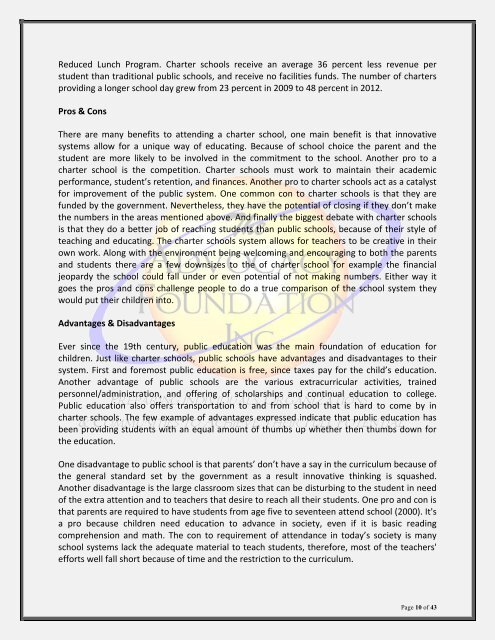The 21st Century Charter Schools Initiative
The 21st Century Charter Schools Initiative
The 21st Century Charter Schools Initiative
You also want an ePaper? Increase the reach of your titles
YUMPU automatically turns print PDFs into web optimized ePapers that Google loves.
Reduced Lunch Program. <strong>Charter</strong> schools receive an average 36 percent less revenue per<br />
student than traditional public schools, and receive no facilities funds. <strong>The</strong> number of charters<br />
providing a longer school day grew from 23 percent in 2009 to 48 percent in 2012.<br />
Pros & Cons<br />
<strong>The</strong>re are many benefits to attending a charter school, one main benefit is that innovative<br />
systems allow for a unique way of educating. Because of school choice the parent and the<br />
student are more likely to be involved in the commitment to the school. Another pro to a<br />
charter school is the competition. <strong>Charter</strong> schools must work to maintain their academic<br />
performance, student’s retention, and finances. Another pro to charter schools act as a catalyst<br />
for improvement of the public system. One common con to charter schools is that they are<br />
funded by the government. Nevertheless, they have the potential of closing if they don’t make<br />
the numbers in the areas mentioned above. And finally the biggest debate with charter schools<br />
is that they do a better job of reaching students than public schools, because of their style of<br />
teaching and educating. <strong>The</strong> charter schools system allows for teachers to be creative in their<br />
own work. Along with the environment being welcoming and encouraging to both the parents<br />
and students there are a few downsizes to the of charter school for example the financial<br />
jeopardy the school could fall under or even potential of not making numbers. Either way it<br />
goes the pros and cons challenge people to do a true comparison of the school system they<br />
would put their children into.<br />
Advantages & Disadvantages<br />
Ever since the 19th century, public education was the main foundation of education for<br />
children. Just like charter schools, public schools have advantages and disadvantages to their<br />
system. First and foremost public education is free, since taxes pay for the child’s education.<br />
Another advantage of public schools are the various extracurricular activities, trained<br />
personnel/administration, and offering of scholarships and continual education to college.<br />
Public education also offers transportation to and from school that is hard to come by in<br />
charter schools. <strong>The</strong> few example of advantages expressed indicate that public education has<br />
been providing students with an equal amount of thumbs up whether then thumbs down for<br />
the education.<br />
One disadvantage to public school is that parents’ don’t have a say in the curriculum because of<br />
the general standard set by the government as a result innovative thinking is squashed.<br />
Another disadvantage is the large classroom sizes that can be disturbing to the student in need<br />
of the extra attention and to teachers that desire to reach all their students. One pro and con is<br />
that parents are required to have students from age five to seventeen attend school (2000). It's<br />
a pro because children need education to advance in society, even if it is basic reading<br />
comprehension and math. <strong>The</strong> con to requirement of attendance in today’s society is many<br />
school systems lack the adequate material to teach students, therefore, most of the teachers'<br />
efforts well fall short because of time and the restriction to the curriculum.<br />
Page 10 of 43

















